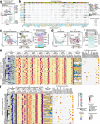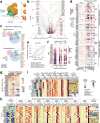This is a preprint.
Early Developmental Origins of Cortical Disorders Modeled in Human Neural Stem Cells
- PMID: 38915580
- PMCID: PMC11195173
- DOI: 10.1101/2024.06.14.598925
Early Developmental Origins of Cortical Disorders Modeled in Human Neural Stem Cells
Update in
-
Early developmental origins of cortical disorders modeled in human neural stem cells.Nat Commun. 2025 Jul 9;16(1):6347. doi: 10.1038/s41467-025-61316-w. Nat Commun. 2025. PMID: 40634286 Free PMC article.
Abstract
The implications of the early phases of human telencephalic development, involving neural stem cells (NSCs), in the etiology of cortical disorders remain elusive. Here, we explored the expression dynamics of cortical and neuropsychiatric disorder-associated genes in datasets generated from human NSCs across telencephalic fate transitions in vitro and in vivo. We identified risk genes expressed in brain organizers and sequential gene regulatory networks across corticogenesis revealing disease-specific critical phases, when NSCs are more vulnerable to gene dysfunctions, and converging signaling across multiple diseases. Moreover, we simulated the impact of risk transcription factor (TF) depletions on different neural cell types spanning the developing human neocortex and observed a spatiotemporal-dependent effect for each perturbation. Finally, single-cell transcriptomics of newly generated autism-affected patient-derived NSCs in vitro revealed recurrent alterations of TFs orchestrating brain patterning and NSC lineage commitment. This work opens new perspectives to explore human brain dysfunctions at the early phases of development.
Keywords: brain patterning; cortical disorders; neural stem cells.
Conflict of interest statement
COMPETING INTERESTS The authors declare no conflict of interest.
Figures





References
Publication types
Grants and funding
- UM1 MH130991/MH/NIMH NIH HHS/United States
- R01 HG010898/HG/NHGRI NIH HHS/United States
- RF1 MH123978/MH/NIMH NIH HHS/United States
- R01 MH113257/MH/NIMH NIH HHS/United States
- R37 DA023999/DA/NIDA NIH HHS/United States
- R24 MH114815/MH/NIMH NIH HHS/United States
- U24 HG012483/HG/NHGRI NIH HHS/United States
- U01 DA053628/DA/NIDA NIH HHS/United States
- R01 MH109648/MH/NIMH NIH HHS/United States
- R01 DC019370/DC/NIDCD NIH HHS/United States
- R01 DA023999/DA/NIDA NIH HHS/United States
- U01 MH116488/MH/NIMH NIH HHS/United States
- U24 HG012108/HG/NHGRI NIH HHS/United States
LinkOut - more resources
Full Text Sources
Miscellaneous
